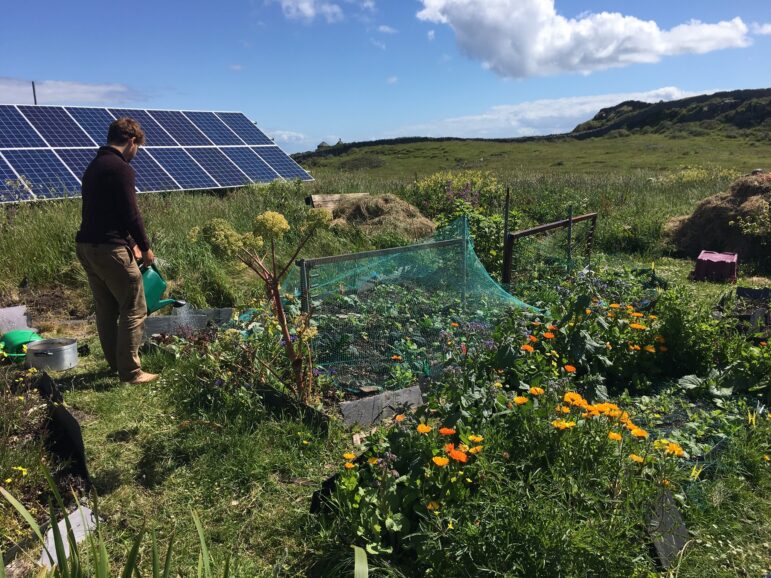
Bioregionalism: A Return to Source
We are living through a moment of intersecting crises: climate change, ecological collapse, geopolitical turmoil and a growing sense of disconnection from nature. In 2024, global temperatures rose to about 2.65°F (1.47°C) above the late 19th-century average. The past ten years have been the hottest on record. Meanwhile, 75% of the Earth’s surface and 66% of marine environments have been heavily altered by human activity, and around one million species are now at risk of extinction.
Many of us can feel this in our bodies and our hearts, through dried-up wetlands, quieter birdsong and thickened summer air. We know that the systems powering our modern, high consumption lifestyles are unraveling the living systems that sustain us, and in doing so, have severed our connection to place, to each other and to the sacredness of the Earth herself.
In response to the climate and ecological emergency, governments and corporations are leaning heavily on technological fixes such as carbon markets or greenhouse gas removal. While these strategies may play a limited role, they are often treated as silver bullets and promoted through well-funded and disingenuous marketing campaigns as if they could replace systemic change. In reality, many of these solutions are not scalable, have uneven or unproven results, and fail to address the root causes of ecological collapse: our economic dependence on extraction and pollution, and our cultural estrangement from the living world.
Therefore, it is now time for us to remember that we are, and always have been, a part of nature. We must feel this in our bones and reorient our societies to live within local ecological systems, rather than extracting from them. This is the quiet, radical invitation of bioregionalism.
Bioregionalism offers a grounded response to ecological crisis, based on belonging, reciprocity and the ongoing practice of reinhabiting place.
Rosie Semlyen
Bioregional Theory
Long before “bioregionalism” had a name, Indigenous communities across North America practiced place-based stewardship—caring for the land through seasonal knowledge, reciprocal relationships, and time-tested methods that sustained biodiversity and ecosystem health. These traditions recognize humans not as separate from nature but as participants in it. This worldview stands in contrast to the dominant Western narrative that ecosystems flourish only when people are removed.
Bioregionalism emerged in the 1970s as a response to the limitations of mainstream Western environmentalism. At the time, efforts to protect nature often focused on drawing boundaries between humans and ecosystems—preserving wilderness by keeping people out. While such strategies helped win vital legal protections, they did little to challenge the deeper cultural disconnection driving environmental collapse. In the environmental writer Peter Berg’s words, environmentalism had become “a hospital that only has an emergency room—it doesn’t have long-term care. It just has a trauma section.”
In contrast, bioregionalism offers a vision of healing that reconnects people with the places they call home. It asks us to reimagine our identities and communities in relationship to the land, aligning human life with the natural systems that sustain it. Rather than relying on fragmented policies or distant, top-down conservation efforts, bioregionalism offers a grounded response to ecological crisis, based on belonging, reciprocity and the ongoing practice of reinhabiting place.
Ecologically, a bioregion is a geographic area defined by its watersheds, mountain ranges, soil types and species distribution, rather than defined by human-imagined political borders. A bioregion is home to multiple ecosystems and is large enough to sustain the interdependent life systems within it.
For hundreds of thousands of years, human communities met their needs for food, water, shelter, energy and medicine in ways that coexisted with their bioregions rather than extracted. People lived with the land, not against it. Bioregionalism invites us to relearn this way of belonging, asking: how can we honor the land’s past and present? What would it mean to root our communities, our economies, our sense of identity in this place?
In this sense, bioregionalism is as much about spirit as it is about science and ecology, imagined both as a geographic reality and a “terrain of consciousness.” It invites us into kinship with the more-than-human world—the trees, animals, rivers and all beings with whom we share life. It asks us to listen. To learn the names of our watersheds. To notice which birds return in spring. To remember where our drinking water comes from and to know the quality of soil for planting and growing food. It is a living practice that evolves through deep listening, local organizing, ecological learning and spiritual humility. When we become apprentices of place and cultivate local economies that nourish people and ecosystems alike, both land and culture thrive.
Indigenous Sovereignty
For bioregionalism to offer a truly grounded and inclusive vision of ecological renewal, it is vital to acknowledge the movement’s blind spots. The concept was largely shaped by white settler scholars, and its rhetoric has at times romanticized, tokenized or appropriated Indigenous relationships with land. This includes problematic framings like Berg and Dasmann’s phrase “becoming native,” which has been widely criticized as it reflects a colonial approach of claiming indigeneity as a practice or a state of mind rather than a birthright. As Robin Wall Kimmerer writes, “Indigenous is a birthright word. No amount of time or caring changes history or substitutes for soul-deep fusion with the land.” Such framings erase the histories of dispossession and the ongoing struggles of Indigenous Peoples for sovereignty, territory, and recognition. As scholar Joseph Wiebe cautions, they risk turning Indigenous knowledge into a resource for settlers to extract from, rather than a call to justice and solidarity.
Kimmerer therefore offers a vital reframing. For non-Indigenous people, the invitation is not to appropriate Indigenous identity, but to cultivate an authentic and enduring relationship with the land. She describes this as “throwing off the mindset of the immigrant” and learning to “live as if we’ll be here for the long haul, as if our children’s future mattered.” This means caring for the land as if our lives—both spiritual and material—depend on it, and as if the land depends on us in return.
Bioregionalism calls us to remember what we have always known—that we are not separate from nature, but shaped by it, held within it and responsible to it.
Rosie Semlyen
This ethic of reciprocity between humans and the land is central to many Indigenous worldviews, often expressed through the everyday practices of land care: harvesting with respect, tending native species, honoring the beings with whom we share our ecosystems. In turn, we enrich our own cultures and spiritual connection with the natural world.As Kimmerer describes, reciprocal restoration is the understanding that healing land and healing culture are intertwined. To restore an ecosystem is also to remember how to be in relationship with it. “What we do to the land, we do to ourselves.”
For non-Indigenous people committed to bioregionalism, decolonization must go beyond symbolic gestures or selective borrowing from Indigenous lifeways. It means following Indigenous leadership in environmental stewardship, supporting rematriation, land return and cultural renewal, and recognizing Indigenous nations not as figures of the past, but as present-day holders of ecological knowledge and political sovereignty. As Dennis Nadeau affirms, we must “listen to the Indigenous voices in the communities in which we are doing our work.”
These values come alive through an ongoing process of responsibility and respect—through the choices we make everyday, the relationships we nurture and the ways we show up for our communities and ecosystems.
Bioregionalism as a Practice
To practice bioregionalism and reciprocal restoration is to re-root our daily lives in the ecological, historical and cultural specificity of the places we live. It is a practice of homecoming, remembering the ancient kinship between human beings and the watersheds, food webs and stories that sustain them.
The bioregionalism movement centers three core goals:
- Restoring and maintaining local natural ecosystems.
- Practicing sustainable ways to satisfy basic human needs, such as water, food, energy, housing and materials.
- Supporting the work of reinhabitation—culturally, spiritually, economically and politically.
This practice might involve harvesting rainwater, honoring Indigenous land stewardship practices, learning the original names of rivers or choosing materials and rituals that arise from local relationships rather than extractive global supply chains. It’s a mode of living that values interdependence over individualism, repair over consumption, and presence over displacement.
The ideas can manifest differently across bioregions. In the Great Plains, it might mean restoring native prairie grasses. In Cascadia, it inspires the reintroduction of salmon runs and the use of community-scale bioenergy. In the Sonoran Desert, it involves adapting solar energy systems to arid ecosystems. And in the Hudson River watershed, it could mean eating locally grown foods, rewilding our gardens and neighborhoods, and supporting initiatives like the Billion Oyster Project, Riverkeeper and the Bronx River Alliance to restore our local watershed.
Faith Communities and Watershed Discipleship
In Indigenous cosmologies, both ceremony and ecosystem restoration are ways of fulfilling spiritual responsibility toward the land and the more-than-human world. This ethic of care—rooted in reciprocity, gratitude, and kinship—might offer a model for all spiritual communities seeking to reconnect with place. As theologian Ched Myers writes, “bioregionalism is a way of life in which we are called to inhabit our watersheds faithfully, as if they really mattered—because they do.”
For faith communities—Indigenous and non-Indigenous alike—bioregionalism can be understood as a call to ecological and spiritual practice. In Christian settings, the framework of Watershed Discipleship, popularized by Myers, invites congregations to re-root their theology, liturgy, and mission in the ecosystems they inhabit.
This could mean:
- Recontextualizing scripture: Reading sacred texts through the lens of local ecology, recognizing how landscapes shape scriptural narratives, and how they shape our own.
- Regrounding mission: Extending care and service not only to human neighbors, but to the entire watershed, as a sacred trust.
- Reforming worship: Designing rituals that reflect the rhythms, blessings, and burdens of the bioregion, like water blessings, climate vigils or ceremonies of restoration.
- Reimagining devotion: As a lifelong journey of learning from place, including Indigenous knowledge keepers, ecological caretakers and the land itself.
This is a justice-rooted spirituality that holds both the Earth and its people in sacred regard. Faith communities might begin the bioregional journey by mapping their watershed, installing solar panels, transforming their grounds into food forests or pollinator gardens, participating in mutual aid during disasters, and joining coalitions for environmental and climate justice that are rooted in local relationships.
To restore an ecosystem is also to remember how to be in relationship with it.
Rosie Semlyen
Homecoming
Ultimately, bioregionalism calls us to remember what we have always known—that we are not separate from nature, but shaped by it, held within it and responsible to it. This is as much a spiritual journey as it is an ecological one. It asks us to reclaim the ancient, embodied wisdom that comes from living in deep relationship with place—to let our lives be shaped by the contours of the land, the flow of the watershed, the seasons of return. This is quiet, slow work; a practice of reverence, of reciprocity and of responsibility. One that honors both the limits and the abundance of the Earth, reminding us that care for the land is inseparable from care for community, from justice, from spiritual wholeness.
And so, we begin here, where our feet touch the ground. In the places we call home, however imperfectly. In our watersheds, our neighborhoods, our communities. We begin by listening to the land, to its first peoples, to one another—and learning once again to live in ways that replenish and restore the natural world.
Feature photo courtesy of Shannon MD Smith.

